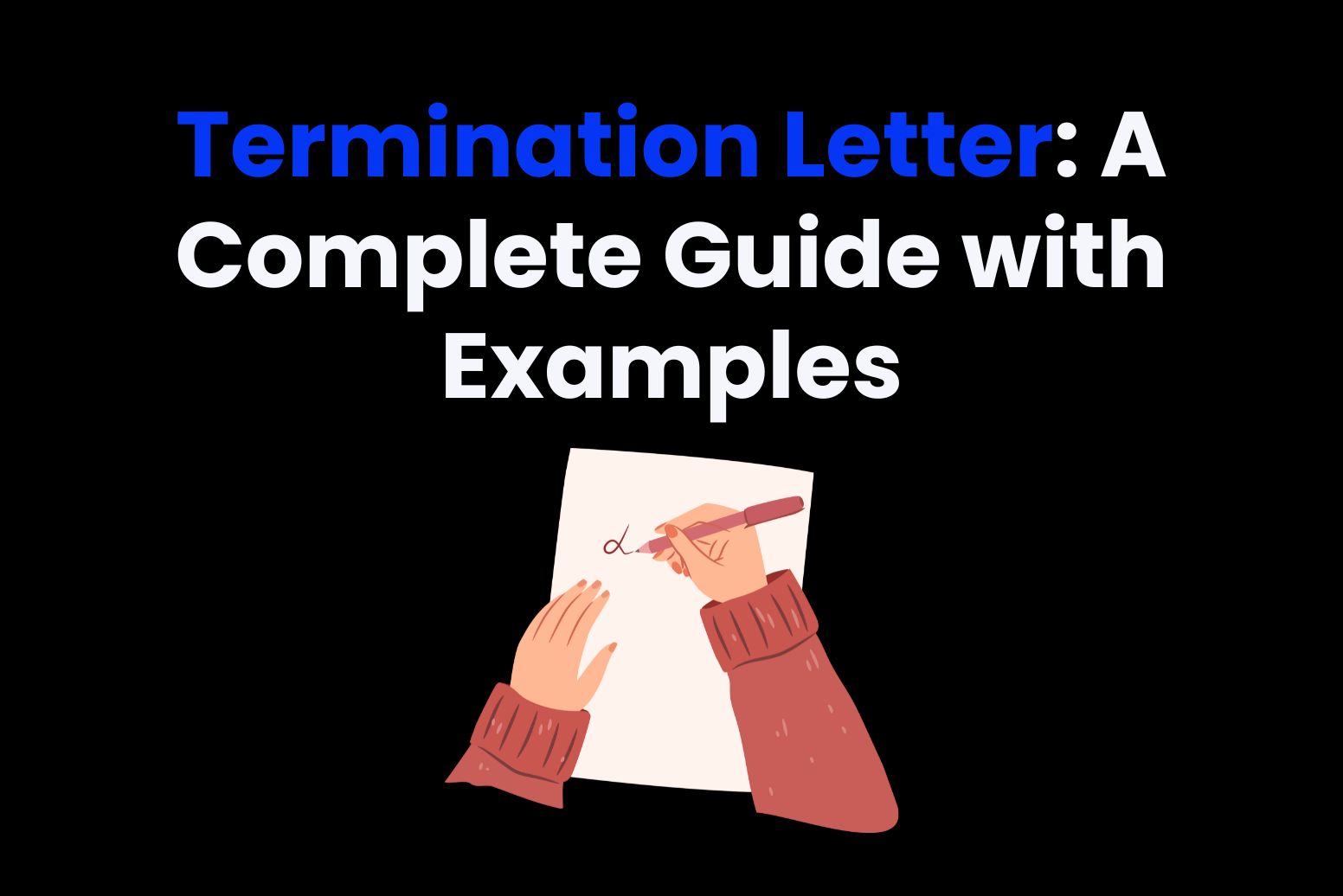A termination letter is that formal notification letter the employer uses to officially tell the employee of their employment termination. It is a professional method of conveying reasons for the terminations and other related information about the procedure, such as severance pay and last working dates, etc. The importance of clear writing, professionalism, and adherence to legal requirements makes an outstanding termination letter indispensable. This paper describes the purpose, format, and importance of termination letters, together with examples and best practices. Readers will gain insight into how one could write compliant and ethical letters and understand their legal and professional importance and how disagreement and miscommunication may be minimized.
What Is a Termination Letter?
A termination letter is an official letter that the employers use to communicate the end of an individual’s job. It is essentially formalizing the process of letting an employee go, meaning it gives a person a reason and terms with subsequent action on leaving.
Important Functions of a Termination Letter
Termination letters provide for several important functions:
- Documentation: They build a written record of the termination for both the employer and the employee.
- Clarity: Specifically mentioning the grounds and conditions, they minimize the chance of miscommunication.
- Legal Compliance: Most countries require a formal termination letter to legally follow labor laws.
- Professionalism: An effective letter maintains the goodwill of the company and reflects professionalism.
Key Elements of a Termination Letter
An excellent termination letter should have the following:
- Date and Header: It must provide date, company name, and employee information.
- Reason for Termination: A clear statement of why the termination is happening either due to performance, downsizing, or any other reason.
- Effective Date: A statement of when the termination date is going to be effective.
- Severance and Benefits: Severance pay, continuation of benefits, and any unused leave payout.
- Return of Company Property: Procedures for returning items such as laptops or ID cards.
- Legal Rights: Any rights applicable, including unemployment benefits or non-compete clauses.
- Contact Information: Include the details of a contact person in case of further clarification.
Differences between Termination Letters and Resignation Letters
Both are termination letters, but both differ significantly in intent and origin:
Termination Letter: This is initiated by the employer, and most of the time, outlines the reasons for involuntary termination.
Resignation Letter: It is written by the employee and states the voluntary decision-making in leaving.
Legal and Ethical Aspects of Termination Letters
Termination letters are very well laden with the legal and ethical components, which mean their contents and delivery become pretty crucial. Employers must ensure that the process is compliant, fair, and respectful to avoid legal complications or reputational damage.
Legal Obligations When Issuing Termination Letters
For the employers, this would typically mean following the labor laws and regulations through the process of terminating employee with a termination letter where applicable. The main legal considerations are:
- Notification Requirements: Many jurisdictions prescribe notice periods for termination.
- Wrongful Termination: Such as when workers are discharged without cause, contrary to contract, or even cases of discrimination. Example: A worker who was let go for whistleblowing on safety concerns in the workplace can file a wrongful dismissal case.
- Final Paychecks and Benefits: Employees must be paid all wages and benefits due, including vacation cheques, upon exit.
- Compliance with Contracts: Discharges should reflect the existence of any employment contracts or union collective agreements.
Ethical Considerations to Ensure Fairness
- Transparency: Employees should clearly understand the reasons for their termination.
- Empathy: A termination letter should avoid harsh or demeaning language.
- Support: Offering resources, such as outplacement services, demonstrates goodwill and helps the employee transition.
- Consistency: Similar cases should be handled uniformly to prevent perceptions of favoritism or bias.
Impact on Employer Branding and Employee Morale
- Employer Branding: The way an organization handles terminations reflects its culture and values. Respectful and compliant terminations can maintain or enhance the company’s reputation.
- Employee Morale: Unfair or poorly handled terminations can create fear and dissatisfaction among remaining employees, lowering productivity and trust.
Best Practices for Legal and Ethical Compliance
- Seek Legal Counsel: Before issuing a termination letter, consult a legal professional to ensure compliance.
- Follow Policies: Terminate based on the policies and procedures set by the company.
- Provide Feedback: Share some constructive criticism while letting him know about your decision so that he could learn from it for the next roles.
- Prepare for Questions: Anticipate their questions that they may ask them upon receiving the letter
Types of Termination Letters
Voluntary Termination Letter
A Voluntary Termination Letter is one which an employee writes when deciding to resign from his position. The letter informs the employer that he or she is leaving their organization of his own free will. It is always proper to be professional, communicate in advance (normally two weeks), and show appreciation for the opportunity. Briefly explain the reason(s) for leaving without getting bogged down with unnecessary detail. Main parts of the letter are:
- A lucid statement of resignation.
- Introduction of the effective date.
- A positive closing statement, wishing the company continued success.
Involuntary Termination Letter
Involuntary termination describes the situation whereby an employer decides that they no longer want an employee working for them. This might be based on various factors, including a business’s needs, restructuring, or the employees’ behavior. The letter remains respectful and professional while recognizing the employee’s contribution by properly stating the reason for termination. It includes:
- A short reason for termination.
- A reference to the employee’s performance or conduct (if applicable).
- Final paycheck information, benefits, and what to expect next (return of company property, for example).
- Any severance package or assistance offered.
Termination Due to Poor Performance
A poor performance termination letter is presented by giving grounds to an employee who was released for failure to meet the set expectations. This letter should clearly outline the performance issues and evidence efforts to improve the behavior including performance reviews, warnings, or disciplinary action. The letter should be factual and not harsh. This mainly consists of;
- Summary of performance issues.
- Information about warnings or improvement plans previously given.
- Mentioning of any formal performance appraisal.
- Details about final pay, benefits, and exit procedures.
Layoff Termination Letter
A layoff termination letter takes place when there is termination of an employee by a business for reasons like budget cuts, downsizing, restructuring etc., which are usually not performance-related termination. The tone of the letter should be empathetic, in which the decision’s impact is recognized but a legitimate reason for the layoff is given. This letter also details the employee’s benefits, severance package, and what support will be offered with regard to the transition. Key elements include:
- Explain why the layoff is essential – financial constraints, departmental changes, etc.
- Severance pay, unemployment benefits, health insurance continuation details.
- Instructions on how the company will help the employee to find alternative employment (if applicable).
Sample Templates for Each Type
Providing sample templates for each type of termination letter may ensure clarity and professionalism. Here is a very brief outline for each type:
- Voluntary Termination Letter: “Dear [Manager], I am writing to formally resign from my position as [Job Title] effective [Date]. I have really enjoyed my time at [Company], and I am thankful for the opportunities that have been afforded me. Please advise me on what you need from me for the transition.”
- Involuntary Termination Letter: “Dear [Employee], After careful consideration, we regret to inform you that your employment with [Company] will be terminated effective [Date] due to [reason]. We appreciate your contributions and wish you the best in the future.”
- Termination Due to Poor Performance: “Dear [Employee], After multiple discussions regarding your performance, we regret to notify you that your employment with [Company] will be terminated, effective [Date]. Despite our efforts to provide feedback and guide you, the expected level of performance was not met.”
- Layoff Termination Letter: “Dear [Employee], Due to [company’s restructuring, financial situation, etc.], we regret to inform you that your position has been eliminated effective [Date]. This decision is not a reflection of your work, and we will assist you during this transition.”
How to Write a Termination Letter: Step-by-Step Guide?
Preparing the Content (Facts, Reasons, Legalities)
All facts must be gathered before writing the termination letter. These include whether the dismissal is a result of a resignation, layoff, or performance-related-for cause. Make sure that the factual claims are accompanied by proof, such as performance reports, warnings, or business decisions. It is also essential to know what legal obligations and company policies require to be observed in any such case, especially about severance, final pay, and benefits. If you want to learn how to say “Sorry for the Confusion” to your boss here the best guide
Choosing the Right Tone and Language
The termination letter tone is crucial to keep the atmosphere professional and avoid unnecessary conflict. It should be assertive yet clear, direct, and respectful, empathetic. In the case of involuntary termination or layoff, the vocabulary should be sympathetic and encompass the hardship of the situation without appearing accusatory. Negative or highly emotive words and expressions must be avoided at all costs for a professional ambiance.
Structuring the Letter
Header and Recipient Details
The letter should start with the date and other relevant details of the recipient, such as their name, job title, and address. This sets a formal tone and clarifies the recipient of the letter. AI Letter Writer help you to do all this stuff.
Opening Statement
The opening of the letter should be straightforward and to the point. It should state clearly that the employment of the employee is being terminated and include the effective date. The tone should be neutral and straight in order not to confuse or make ambiguity. Example: “We regret to inform you that your employment with [Company] is terminated effective [Date].”
Detailed Explanation and Supporting Evidence
The body of the letter should explain the rationale for the termination. For voluntary resignations, it could include the employee’s reason for leaving, if provided. In cases of involuntary termination, include the reasons-for example, performance issues or layoffs-and as much detail as possible about prior warnings, reviews, or disciplinary action. For example: “Your performance has not met the expectations outlined in your performance reviews despite previous feedback and coaching.”
Closing Statement and Next Steps
Conclude the letter by outlining next steps for the employee. This includes information about final pay, benefits, severance packages, return of company property, and any assistance the company will provide. It’s also important to provide the employee with contact information for any further inquiries. Example: “Please arrange to return any company property by [Date]. Your final paycheck, including unused vacation days, will be provided on [Date]. In case of any queries, you can reach the [HR Department] at your convenience.
Common Mistakes to Avoid
- Lack of Clarity: Avoid ambiguous language that could create confusion on the recipient’s part about what is happening, including termination details such as reasons for leaving or further action.
- Being Too Informal: Although the circumstances are cordial, a letter is always formal.
- Over-explaining or Providing Too Much Detail: While it’s good to be transparent, providing more than necessary descriptions of the employee’s weaknesses, personal reasons, or unrelated issues can become very dragging.
- Not Including Legal or Policy Information: Forgetting to mention essential details like severance pay, final paycheck, or unemployment benefits create misunderstandings and possible future lawsuits.
Importance of Automation in Writing Termination Letters
Termination letters are the most important papers in any company because they note the end of any employment relationship. These letters are not only sensitive but should be crafted with so much care and precision. However, drafting termination letters manually poses various challenges for HR professionals. The need for automation has thus become an invaluable tool in contemporary workplaces.
Challenges Faced by HR Professionals When Drafting Termination Letters Manually
Time-Consuming Process:
Writing hand termination letters is very time-consuming and can turn out to be too lengthy an exercise if the HR department is dealing with multiple employees. Every letter requires individual attention and personalization, and observance to company policies, which results in the HR professional getting burnt out. So here we have compiled the ChatGPT Prompts for Cover Letter which can also save your time.
Risk of Human Error:
The reason drafting termination letters manually can prove risky is due to human error. While important details may be lost or the wrong legal language is utilized, such mistakes can lead to confusion, legal complications, and wrongful termination claims.
Maintaining Consistency:
All of the termination letters would be difficult to maintain in consistent style if they were written with a hand. Diverse HR professionals working on different letters may have different styles. Such might lead to differences in tone, structure, or legal language used.
Legal and Compliance Concerns:
Employment laws are different and varied from region to region. It can be challenging to create handwritten termination letters that go in accordance with the local and national-level laws. Without proper knowledge, the intimidation of failure to address the legal requirement can put one at a risk of litigation.
Benefits of Automation Tools Like Accuracy, Speed, and Compliance
- Accuracy: The automation tools like Arvin AI provide pre-built templates that have been created to be of legal and organizational standards. Thus, all the required details would be given, and there would be less possibility of errors.
- Speed: Automation avails the HR professional with the opportunity of completing a termination letter within a couple of minutes instead of several hours of crafting the letters in entirety. This saves time for the HR professionals in order to concentrate on other important work.
- Compliance: The most important advantage of automation is built-in compliance checks. The programs will have up-to-date legal standards and company policies embedded in the automated systems, making sure the termination letters strictly comply with labor laws to avoid any sort of legal problems that may arise.
- Consistency and Professionalism: Through termination letter automation, consistency in tone and format is given, so the termination letters remain professional yet respectful and represent the well-being of the company in that regard. This is a matter of great concern when taking up employment termination.
Arvin AI: Your Ultimate Tool for Crafting Termination Letters
Arvin AI is one of the most advanced tools developed to change the way writing termination letters should be forever. In so doing, this makes it easier to facilitate the whole process within which HR professionals can quickly produce legally compliant and empathetic letters. Arvin AI is a powerful tool with AI-powered tone customization, pre-designed templates, and legal compliance features. The tool will be a game-changer for companies who wish to save time, make the most accurate termination communication possible, and ensure that their termination communication is legal.
Key Features of Arvin AI
- Pre-Designed Templates for Various Scenarios: It provides ready-to-use templates for termination due to performance, downsizing, and misconduct.
- AI-Powered Tone Customization: Enables tone adjustments for professionalism and sympathy, depending on the sensitivity of the case.
- Built-in Legal Compliance Checks: It assists in ensuring the letters are compliant with jurisdiction-based labor laws and company policies.
- Customizable Fields: Employee-specific information such as his name, position, and reason for termination can be added quite smoothly.
- Fast and Accurate Letter Generation: Generate professional termination letters in no time. For HR professionals, that saves hours of effort.
Steps to Use Arvin AI for Writing a Termination Letter
Step 1: Getting started with Arvin AI is as simple as going to the website, creating an account if you haven’t already done so, and logging in with one when present.
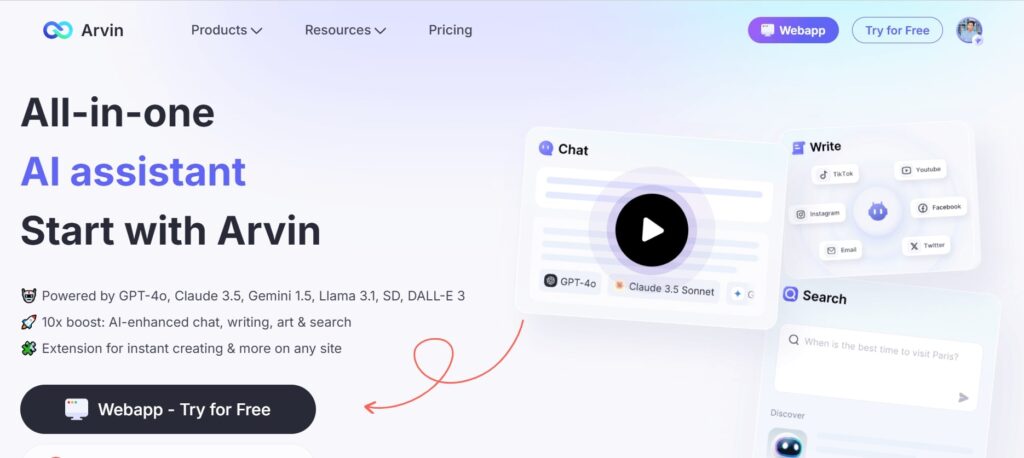
Step 2: Once logged in, navigate to the template library and select the “AI Article writer” option. This will bring up new dashboard to write anything which you need.
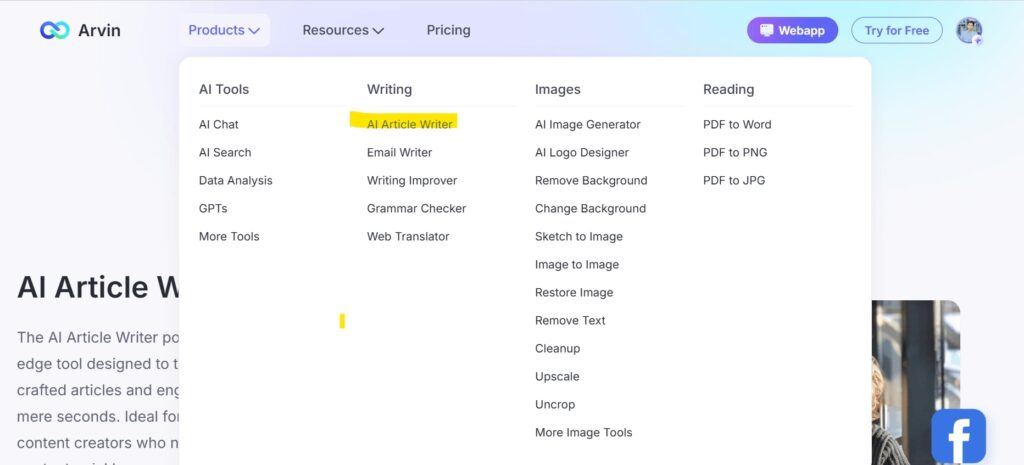
Step 3: Next, you’ll be prompted to fill in specific details about the employee and the circumstances surrounding the termination. This includes the employee’s name, position, the reason for termination, and any relevant severance or benefits information.
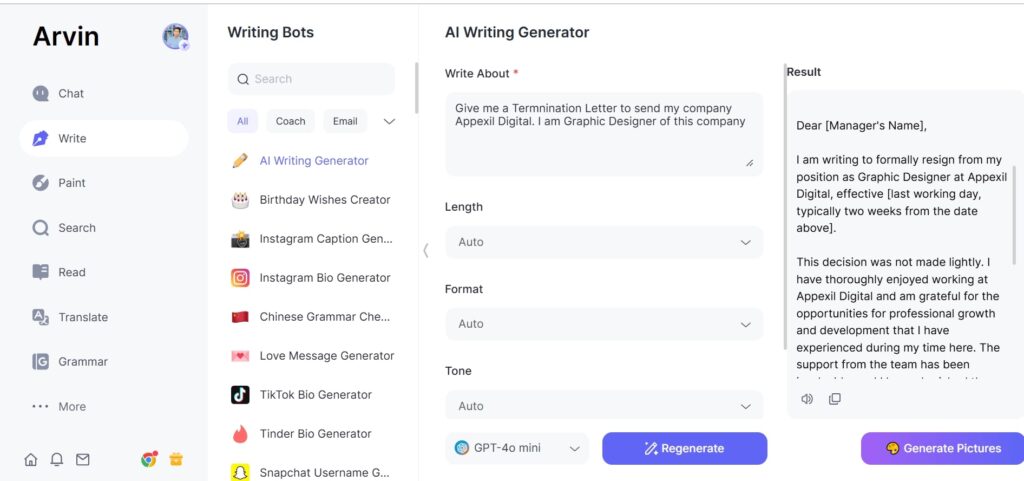
Step 4: Arvin AI’s tone adjustment tool means you can come up with the perfect tone for your letter. Whether it’s formal, empathetic, or neutral, adjusting that slider changes the mood in the letter to match what you want to convey.
Step 5: Once the letter is customized, now click on the button to copy the letter.
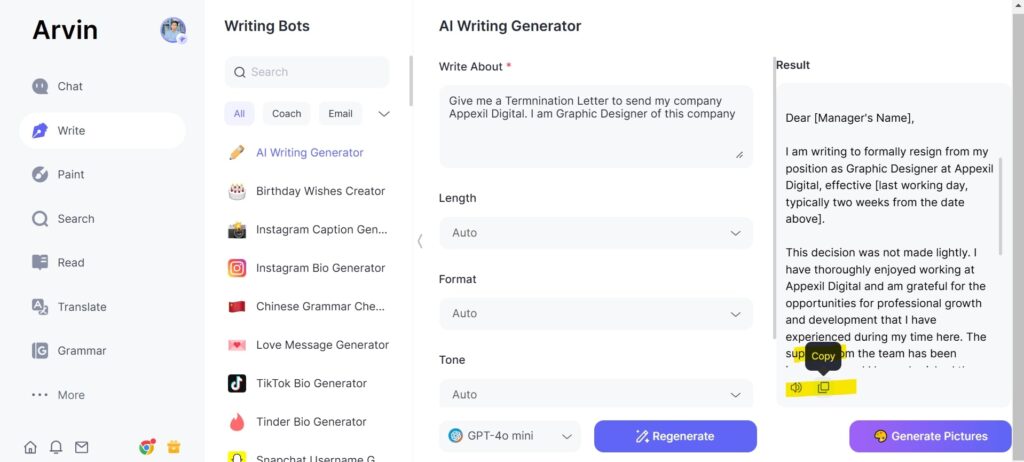
To create a legally compliant, professionally written termination letter, HR professionals can simply use the flow steps outlined here with Arvin AI, thus saving time and ensuring accuracy in the process.
Conclusion
Termination letters are documents that include clarity, professionalism, and legal as well as ethical standards. They are a formal record of an employment decision that outline the reasons behind termination and what comes next for the employees being let go. Modernization of termination letter techniques, therefore, using tools such as Arvin AI ensures easy and rapid production in ways that minimize the potential mistakes or omissions that could lead to legal action. Arvin AI can help companies streamline the process, maintain compliance, and fulfill their ethical duties.
Termination Letter FAQs
Q1: Is it true that all organizations must have a termination letter?
Termination letters are not always mandatory for every kind of business because the regulations differ from country to country and industry to industry. But as a good business practice, these letters are provided as it helps in maintaining the record of decision clearly with less chance of legal disputes from the employer’s side as well as increasing transparency for the employee. In some jurisdictions, failure to provide written documentation may lead to legal penalties.
Q2: How to handle employee reactions on a termination letter?
A termination letter must be written with sensitivity and professionalism. Reactions should be expected, such as shock, anger, or tears. Clear explanations about reasons for termination are necessary. Offer support like outplacement services or even counseling and communicate in a calm, empathetic manner. Make sure the environment is private and respectful so that the dignity of the employee is preserved.
Q3: Can a termination letter is contested in court?
Yes, an employee can contest a termination letter in court if they believe the termination was unjustified or discriminatory. The letter may be scrutinized for inconsistencies, lack of documentation, or non-compliance with labor laws. To mitigate risks, include factual, objective, and legally compliant details. Arvin AI can help craft termination letters that adhere to local legal requirements, reducing exposure to disputes.
Q4: What are the legal risks of not issuing a termination letter?
Several legal risks may arise when an employer fails to issue a termination letter. Among them are wrongful termination, lack of due process, and violation of labor laws. An employee is likely to win his case if challenged in court, as proof of validity of a decision is difficult without written evidence. Termination letters protect the rights of an employee and the interests of an employer.
Q5: How can Arvin AI ensure compliance?
Arvin AI streamlines termination letter creation by including regional labor laws and best practices. Thus, it makes sure that all the required elements like reasons for terminating, severance, and effective date, are placed into the letter correctly. With its user-friendly interface and real-time compliance checks, HR professionals can have their termination letters issued confidently and be well-litigated and professional.

